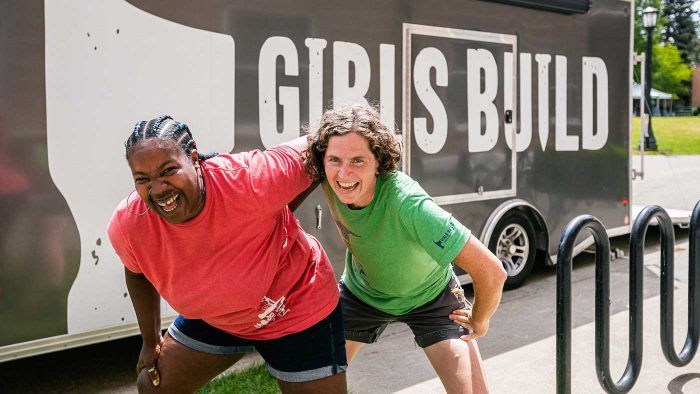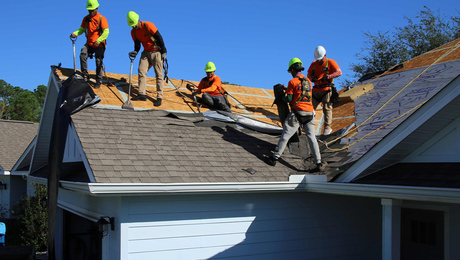Tradesperson Interview: Katie Hughes, Founder of Girls Build
Katie Hughes shares how Habitat for Humanity helped her become a framer, and the what and why behind her organization that teaches young girls the basics of the trades.

After working as a framer and carpenter on remodeling projects and with Habitat for Humanity, Katie Hughes (she/her) started Girls Build, an organization that teaches 8-to-15-year-old girls the basics of tools and the trades.
Q: What kind of trade work do you do and what has been your journey to get there?
K: I am a carpenter and specifically a framer. My journey into the construction industry is different from some folks, though we all take different paths into it. I went to college and got my degree in social work. After I graduated, I volunteered for a year with Habitat for Humanity. I had grown up in rural Oregon, so I already had a lot of basic building skills just from repairing animal pens and building fences. So, I had powertool experience, but nothing formal in terms of building technique and how to do things like framing layout. When I went to the East Coast to work for Habitat, I worked on every aspect of a house you can work on, from concrete forms for the foundation all the way to roofing, trim, caulking, and flooring. When I came back to Portland, Ore., I had rented a house with a friend and I didn’t have a job yet, so I did what I knew how to do which was volunteer with Habitat for Humanity. While I was working, a contractor said I was a really good framer and asked if I was looking for work. This is where a shift happened for me. I had been volunteering for Habitat and it had been really fun, but I realized that this is what I was doing for a living. And I really loved it. I love doing framing and layout. There’s nothing like framing walls on the second-floor deck of a house.
Q: What types of homes or clients did you work with?
K: It was pretty diverse. We did a lot of remodeling in Portland; a lot of buying houses for cheap and flipping them. I actually ended up getting to live in one of the houses that we flipped. I worked with Habitat for Humanity again and did a lot of new builds there. I started teaching building within five years of becoming a carpenter, and I loved it. Through working with Oregon Tradeswomen, I got to help women get into the construction industry. I taught basic tools use, how to read a tape measure, how to be safe, how to act on a job site, how to compose yourself, how to move your body quickly, be direct, speak loudly—all of those things that are hard to know if you haven’t been on a job site before. We gave them the basic skills and also the know-how to be a tradesperson.
Q: How did you transition into Girls Build and what is the vision behind the organization?
K: We were founded in 2016 and just had our sixth anniversary. When I was at Oregon Tradeswomen, we received funding to start a girls camp, which I ran for about eight years. After that time, I left to teach high school construction at a trade school. When the girls camp program ended, I had a lot of tradeswomen coming to me asking what we’re going to do about the next generation. They wanted girls to know that the trades are an option, so that when they graduate high school, they can go into the trades instead of waiting until they are 30, like a lot of tradeswomen do. Finally, this woman said, “Katie, you know when we say, ‘What are we going to do?’ we mean, ‘What are you going to do?” I gathered a group of tradeswomen and made soup and talked about what we liked about the old program and what we would do differently with a new program. So, I started doing all those things I didn’t know how to do like filing paperwork! When we started on our own, we wanted to make this camp what we thought would inspire girls, so we decided 1) it would be fun, 2) we would include as many different trades as possible, and 3) we didn’t want our funding to restrict us; we wanted our funding to open doors.
Our first year, we served 80 girls in Portland. The following year, we served 120 girls and added a week in southern Oregon which included 40 more girls. This summer, we’ll be holding two weeks of camp in southern Oregon, two weeks of camp on the coast, one week of camp in rural Oregon, and three weeks in Portland, and our Portland camp sold out in a minute and 20 seconds.
Q: When girls come to camp, they are exploring a lot of different skills. When a camper leaves at the end of the week, what do you want her to have experienced?
K: She does 20 workshops over the course of the week. Some of the workshops build on each other every day. Every camper has one project they work on every day, so for example last year it was a pinball machine. We want to show that construction can be detail-oriented. Even if you’re 8 years old, if you put in the time, you can make a really cool project. One of our first years, a parent came up to us and said, we’re really used to coming home from camp with macaroni necklaces; now we’re going to be putting the clock she made in the living room. It changes the way parents see their kids.
During the week, we try to do 10 different trades because you never know what will strike someone. Not everyone likes carpentry, so we do sheet metalwork, electrical, blacksmithing, firefighting, fine woodworking, framing (they build a playhouse as a group project), auto mechanics, bike mechanics—anything that sounds interesting and that we classify as a trade. One of the important things we talk about with our instructors is that you want campers to have something in their hands within 3 to 5 minutes. They’re not interested in a long explanation; they want to get going and build. And our camps are fun. Our idea is that they learn about the trades by doing them, and they meet all of these tradeswomen so they know it’s a career option and can ask these women questions. But we’re not hammering them over the head with it, because we want it to stay light.
We also make sure they learn some basic tool usage—tape measure, speed square, how to mark on a board, hammer, drill, impact driver, and some sort of power saw. If they are 8 and 9, they learn how to use a jigsaw, and if they are 10 and up, they learn how to use chop saw. It’s cute because 8- and 9-year-olds know that when they turn 10, they get to use the chop saw, so when they come back to camp, the first thing they’ll say is, “I’m 10 this year, guess what I get to do?”It’s a wonderful feeling to have made a kid excited to use a chop saw.
Q: How do parents respond to the program?
K: At the end of our camp weeks, we do a scavenger hunt with the kids and parents where we hang tags all over camp and the girls do what the tag says. We always have a tag that asks to measure a board and cut it with either the chop saw or jigsaw. The parents are watching their daughter and you see them processing that their little girl is standing in front of a chop saw. You can see that the parents are nervous and are trying not to say anything. And the girls do it, and they act like they’ve being using the saw for 100 years.
Q: How many staff members do you have and where are you recruiting from?
K: We have six year-round staff. For our camps, we hire three people per ten girls, and three extra people. We recruit people through word of mouth and in the winter, we test potential instructors by having them come out and teach a small class. We see how she does: is she good with the kids? Is she safe? Does she know what she’s talking about?
Once people start working for Girls Build, they don’t want to leave. We had one instructor who moved to North Carolina, but she takes the whole summer off and comes and works for Girls Build. We have some instructors who travel with us for the whole summer. It is hard to find someone who is skilled, who also is very good with kids, who can also last a whole day teaching kids all day long, and who are as motivated at 4pm as they were at 8am.
Q: What challenges or barriers have you encountered in your learning process and what things have been helpful and supportive?
K: When I first started out as a carpenter, I was very lucky. I was on a team of six at Habitat, with three women and three men and a supervisor. We (the women) were able to win the guys over as they realized that we could and wanted to do the work, but in the beginning, they didn’t think that. One of my favorite moments was when I wanted to learn how to drive the backhoe. But my boss wouldn’t teach me even though he had taught the guys, so one day, I went over to the backhoe and said, “I’m going to teach myself then.” He had never run so fast in his life, and he jumped up next to me and taught me. Eventually, he realized how cool it was that there were people on his team who were as excited about building as he was. He had to let go of the idea that women can’t or don’t want to do this work and had to embrace the opportunity to pass on to us everything that he knew.
When I got back to Portland, my boss that I worked with really believed in me. We were working one day, and this guy came walking by and asked what I was doing there. My boss said, “She’s working.” And the guy said, “She shouldn’t be doing this, this is taking jobs away from men.” And my boss said, “We’re good—move along.” So, I have found in my work that I have been very supported in what I do. There have been times that I have really had to prove myself and I wish that wasn’t true. To bring more people into the fold, it’s important to have role models, and I had a lot of great female mentors here in Portland.
Photo courtesy of Katie Hughes
RELATED STORIES






















